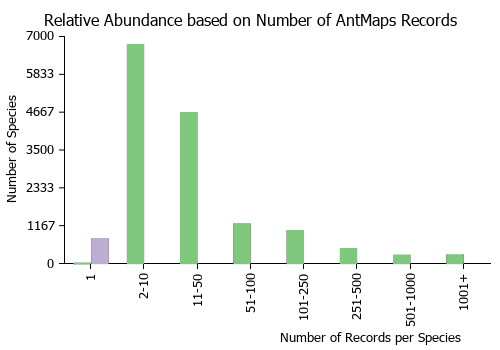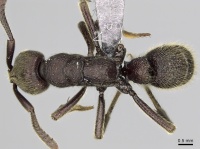Euponera gorogota
| Euponera gorogota | |
|---|---|

| |
| Scientific classification | |
| Kingdom: | Animalia |
| Phylum: | Arthropoda |
| Class: | Insecta |
| Order: | Hymenoptera |
| Family: | Formicidae |
| Subfamily: | Ponerinae |
| Tribe: | Ponerini |
| Genus: | Euponera |
| Species complex: | sikorae |
| Species: | E. gorogota |
| Binomial name | |
| Euponera gorogota (Rakotonirina & Fisher, 2013) | |
The only specimen of this species was captured by leaf litter sampling.
Identification
Rakotonirina and Fisher (2013) - Worker. Anterior margin of clypeus wide and straight, slightly medially notched; mandible smooth between punctulae; eyes small and with very slightly convex surface; antennal scape not surpassing posterior cephalic margin; antennal segments wider towards its apex; metanotal groove deeply impressed; posterolateral margin of propodeum bordered with broad lamella, which project as a tubercle at about the level of the propodeal spiracle; petiolar node anteroposteriorly flattened, its posterior margin medially notched in dorsal view; anterior face of first gastral segment not forming a shallow cavity; antennal scape and outer surface of each tibia covered with erect hairs; dorsum of head near posterior margin and rest of body covered with numerous long, slender hairs.
Euponera gorogota appears to be similar to Euponera maeva by the presence of the impressed metanotal groove and the antero-posteriorly flattened petiole node whose posterior margin is medially notched in dorsal view. But for E. gorgota, the posterior cephalic margin is roughly straight, the posterolateral margin of the porpodeum is bordered with much broader lamella which projects into tubercle at the level of propodeal spiracle, and the antennal scape and outer surface of tibiae are covered with erect slender hairs. In contrast, E. maeva has a more concave posterior cephalic border, narrow lamellae on the posterior margin of the propodeum and its antennal scape and outer surface of tibiae lack erect slender hairs.
Keys including this Species
Distribution
The species is represented by only one worker specimen, which is from the lowland rainforest of Makirovana in the northeast of Madagascar.
Latitudinal Distribution Pattern
Latitudinal Range: -14.1707° to -14.1707°.
| North Temperate |
North Subtropical |
Tropical | South Subtropical |
South Temperate |
- Source: AntMaps
Distribution based on Regional Taxon Lists
Malagasy Region: Madagascar (type locality).
Distribution based on AntMaps
Distribution based on AntWeb specimens
Check data from AntWeb
Countries Occupied
| Number of countries occupied by this species based on AntWiki Regional Taxon Lists. In general, fewer countries occupied indicates a narrower range, while more countries indicates a more widespread species. |

|
Estimated Abundance
| Relative abundance based on number of AntMaps records per species (this species within the purple bar). Fewer records (to the left) indicates a less abundant/encountered species while more records (to the right) indicates more abundant/encountered species. |

|
Biology
Castes
Known only from the worker caste.
Nomenclature
The following information is derived from Barry Bolton's Online Catalogue of the Ants of the World.
- gorogota. Pachycondyla gorogota Rakotonirina & Fisher, 2013: 463, figs. 12, 37, 38, 39, 73 (w.) MADAGASCAR. Combination in Euponera: Schmidt & Shattuck, 2014: 87.
Unless otherwise noted the text for the remainder of this section is reported from the publication that includes the original description.
Description
Worker
(1 specimen): HW: 1.56, HL: 1.79, CI: 87, SL: 1.34, SI: 86, PW: 1.22, WL: 2.67, NH: 1.10, NL: 0.58, NW: 0.98, DNI: 169, LNI: 189.
Head elongate, narrower in front than behind and widest behind level of eyes; posterior margin feebly concave; head dorsum and its lateral surfaces densely and finely reticulate-rugulose or reticulate-punctate. Eyes very slightly convex with more than 30 ommatidia and located in anterior fourth of lateral borders of head. Antennal scape short, not reaching posterior border of head. Anterior margin of clypeus widely transverse and straight, with weak median notch. Mandibles smooth and shiny apart from hair bearing punctures; masticatory margins with ten teeth or denticles.
With mesosoma in dorsal view, metanotal groove deeply impressed and sinuate; in profile, dorsal outline of mesosoma complex, mesonotum distinctly convex; mesopleural suture visible; posterior margins of propodeum covered with broad lamella extending into a lobe or tooth at the level of propodeal spiracle. Mesosoma coarsely reticulate-rugose. Petiolar node anteroposteriorly flattened in profile, anterior face roughly straight and joining the dorsum at a rounded angle; posterodorsal angle feebly overhanging the slightly sinuate posterior margin of node. In dorsal view, posterior margin medially excised. Anterior face of first gastral segment straight, without shallow cavity or impression.
Head and body covered with many long, thin, and erect golden hairs; pubescence abundant on head and pronotum, and quite reduced on the rest of body dorsum. Coloration dark brown, with brown apices of antenna and tip of gaster.
Type Material
Holotype worker: Madagascar, Antsiranana, Makirovana Forest, -14.1707, 49.9541, 415 m, rainforest, sifted litter, 28–29 Apr 2011 (B.L. Fisher et al.) collection code: BLF26523, specimen code: CASENT0166009 (California Academy of Sciences).
References
- Rakotonirina, J.C. & Fisher, B.L. 2013. Revision of the Pachycondyla sikorae species-group (Hymenoptera: Formicidae) in Madagascar. Zootaxa 3683, 447-485.
- Schmidt, C.A. & Shattuck, S.O. 2014. The higher classification of the ant subfamily Ponerinae (Hymenoptera: Formicidae), with a review of ponerine ecology and behavior. Zootaxa 3817, 1–242 (doi:10.11646/zootaxa.3817.1.1).

